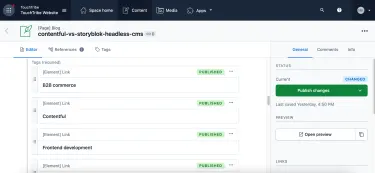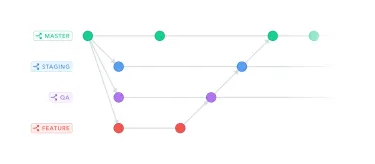Technologie • 16.03.2023
CMS
Contentful vs. Storyblok: a comparison of Headless CMS systems
17 september 2021
Digital developments are moving fast, even when it comes to content management systems. For example, it is impossible to imagine today's e-commerce strategy without the Headless Content Management System (CMS). These backend-only systems store content safely in the cloud and also allows the use of any front-end tool of your choice.
Choosing a Headless CMS is just as difficult as choosing a traditional CMS. After a brief search you will quickly find about 50 possibilities, with many of the same, but also slightly different functionalities. Maarten, Tech Lead at Touchtribe, has recently worked with two major Headless CMS systems: Contentful and Storyblok. He compares the platforms on a number of important points.
Visualization of content
Development process
Linking of data
Costs of (extra) functionalities
Managing content
First of all we will briefly explain the two platforms.
Delen
What is Contentful?
Contentful is currently one of the most popular Headless solutions, offering users an excellent toolset to create and manage content. Because frontend and backend are separated, developers can deploy content with any programming language, on any platform for the best user experience.

What is Storyblok?
Storyblok offers a unique combination of visual editing tools and highly customizable built content blocks for marketers, on top of a modern Headless architecture that gives developers the flexibility to build fast and reliable digital platforms.

Comparison between Contentful and Storyblok
We compare the two platforms below based on a number of points. These focus on development, cost and integration capabilities with other solutions in an organization's digital tech stack.
Visualization of content
A USP of Storyblok is that this platform is very visual. When content is edited, the content editor immediately gets a preview of what it will look like. The environment where the content is edited and the final page are displayed in real time on a single screen. This makes it easy for marketers to use the CMS. A counterpoint, however, is that Storyblok is very focused on creating (responsive) websites, but not, for example, on creating a mobile app.
Contentful, on the other hand, is, allowing you to quickly reuse content. By working with entities you can quickly integrate data into other platforms, think of a mobile app, a chatbot or even brochures. When you think broader than one platform, Contentful could be a better choice.
Development process
The development process of both systems is almost the same. There is no difference in knowledge level. In this case, however, Contentful is more flexible in terms of reusing code. In the case of Contentful, you can reuse unlimited content in different places within the platform. Not just text, but also images, products or data, for example.
Storyblok is a little different. Because reusing content comes at the expense of visualizing it. That's why an important usp of StoryBlok is lost and Contentful scores just that little bit better. When a platform contains many content items, it is more difficult to maintain an overview. So when scalability is more important than visualization, Contentful is a stronger choice as a CMS.
Linking data
In addition to visualization and the development process, it is important to think about linking data sources. Take as an example linking products from a platform like BigCommerce with the CMS. At Contentful, this is basically a manual process, where the product IDs are added to the site. Each time a new product and therefore a new ID is added to the Commerce platform, the CMS must also be updated manually.
This can be worked around with development, but it is relatively a lot of work.
Storyblok has a nicer standard solution for this, using an API to retrieve the data from (in this case) BigCommerce. This link is easy to make with any external data source you can think of. This way, the information on the platform is always up-to-date. Does your company have to deal with many changing products? Then it is wise to look further into Storyblok.
Costs
Looking at the total cost of a Headless CMS consists of several parts. There are a number of standard features almost identical, but many companies also need certain 'premium' features. These often come with higher licensing costs. Think for example of adding different languages to the platform or working with different roles among users.
Both platforms have an Enterprise plan, which can only be taken out on a custom basis. In the case of StoryBlok this starts at € 2,999 per month and for Contentful the same should be considered as a lower limit.
StoryBlok has 4 self-service plans, one of which is free. This can be used with 1 user/seat. The paid plans offer more features and are charged at a fixed price per month, per seat. This starts at € 20 per seat and increases to € 45 per seat. What is remarkable here is that StoryBlok has no restrictions in terms of content types and languages.
Contentful simplified its self-service plans some time ago. There is a free community edition, which can suffice for many organizations. The main limitations are in the number of languages, the number of content types and a limit in the number of content items. The paid self-service plans start at $489 per month for the medium plan (including 10 seats). The large varian costs $849 per month. For this the customer gets more roles, more content types and more content items.
The conclusion we draw in most cases is that the free variant of Contentful is a faster fit for an organization than the free variant of StoryBlok, but that the paid self-service plans of StoryBlok in particular offer significantly more features for a smaller amount of money.
If there is a need for a solid SLA, custom support and even more features, then an Enterprise License is advisable. In this respect, the two parties do not differ much from each other and it is important to be clear about what your organization needs. Of course, Touchtribe is happy to help with that.
Managing content in an OTAP street
Managing content within an OTAP street (development, test, acceptance, production) can be quite an intensive task. For a content editor it is nice when the content of the test environment does not have to be entered again when the site goes live, but can be entered with one push of a button. It's also nice for a developer that when a website is further developed, testing can be done with current content from the production environment.
Contentful has solved this problem in a very solid way. Contentful has a very extensive version management system. In this way, content can easily be migrated between the different Contentful environments without affecting the live environment. Additionally, the various fields can also be migrated using the Contentful Command Line Interface (CLI). The use of the CLI is recommended for larger projects. The structure of the content is then incorporated into the code, making it easy for several people to work on it at the same time.
Storyblok, like Contentful, also has a CLI which is available as an npm-package. Version control, on the other hand, is a lot less extensive and visual than in Contentful. Where Contentful has multiple environments by default, Storyblok needs to configure this separately. Within Contentful, the number of environments depends on the chosen subscription, while in Storyblok a separate subscription must be taken out for each environment. Overall, we can conclude that Contentful is more advanced in this area.

The choice between Contentful and Storyblok
This choice depends entirely on the needs of the organization. How many products do they work with, what sources do they use, how important is visualization, what is the budget? These questions play a big role in the choice of a platform.
Are visualization and interfacing with external systems important? Then Storyblok would be a good choice. Is managing the environment and the development process important? Then Contentful is definitely a must.
Touchtribe is an official partner of both Contentful and StoryBlok, but we always make the trade-off with other Headless CMS systems, such as Prismic or Dato CMS. This way we always look at what suits the client best. We not only fully set up the CMS system, but also provide a unique web shop and shopping experience. Fully integrated with commerce systems such as BigCommerce. Need advice on choosing a headless CMS? Please feel free to contact us.
Delen

